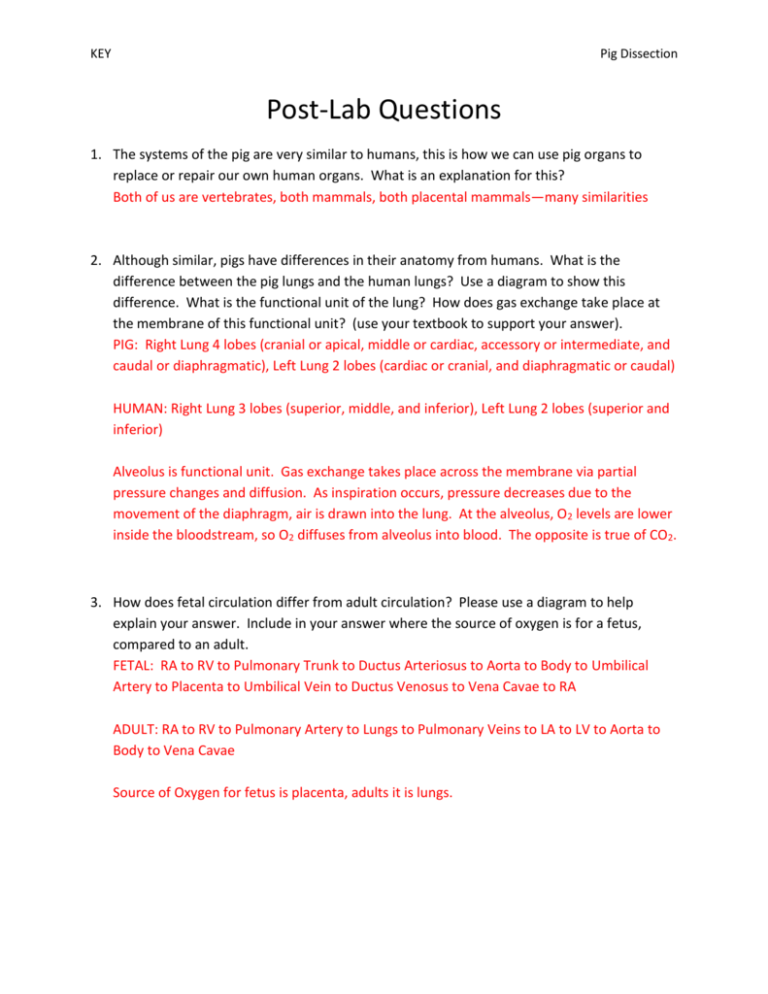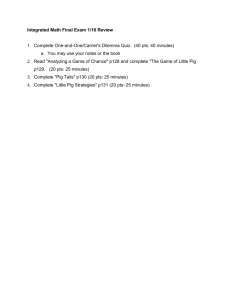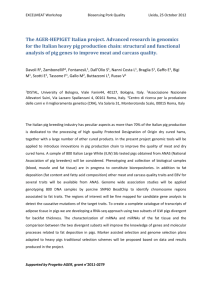KEY Pig Dissection Post-Lab Questions The systems of the pig are
advertisement

KEY Pig Dissection Post-Lab Questions 1. The systems of the pig are very similar to humans, this is how we can use pig organs to replace or repair our own human organs. What is an explanation for this? Both of us are vertebrates, both mammals, both placental mammals—many similarities 2. Although similar, pigs have differences in their anatomy from humans. What is the difference between the pig lungs and the human lungs? Use a diagram to show this difference. What is the functional unit of the lung? How does gas exchange take place at the membrane of this functional unit? (use your textbook to support your answer). PIG: Right Lung 4 lobes (cranial or apical, middle or cardiac, accessory or intermediate, and caudal or diaphragmatic), Left Lung 2 lobes (cardiac or cranial, and diaphragmatic or caudal) HUMAN: Right Lung 3 lobes (superior, middle, and inferior), Left Lung 2 lobes (superior and inferior) Alveolus is functional unit. Gas exchange takes place across the membrane via partial pressure changes and diffusion. As inspiration occurs, pressure decreases due to the movement of the diaphragm, air is drawn into the lung. At the alveolus, O2 levels are lower inside the bloodstream, so O2 diffuses from alveolus into blood. The opposite is true of CO2. 3. How does fetal circulation differ from adult circulation? Please use a diagram to help explain your answer. Include in your answer where the source of oxygen is for a fetus, compared to an adult. FETAL: RA to RV to Pulmonary Trunk to Ductus Arteriosus to Aorta to Body to Umbilical Artery to Placenta to Umbilical Vein to Ductus Venosus to Vena Cavae to RA ADULT: RA to RV to Pulmonary Artery to Lungs to Pulmonary Veins to LA to LV to Aorta to Body to Vena Cavae Source of Oxygen for fetus is placenta, adults it is lungs. KEY Pig Dissection 4. What are the major differences you noticed in the digestive tract of the pig, compared to the human tract? This can be explained by what type of animal the pig is, compared to humans. What type of animal is the pig? Use this information to help you explain the differences in the digestive tract. (See pp. 42-44). Spiral colon like ungulates with sectioned stomach—primitive ruminants. Pig also has cecum, taenia (saculated colon with muscles on one side). Ruminants have 3 chambered stomach, pigs have only 2 chambers but 4 regions (esophageal, cardiac gland, region of proper gastric glands, and pyloric) Pigs have some characteristics of a monogastric (1 chamber in stomach) herbivore as well as some characteristics of a ruminant. 5. Read the section: Histology of the Kidney on pp. 65-66 of the manual. The kidney of the pig functions in the same way as the kidney of the human. What are the functional units of the kidney (of which there are almost 1 million in humans)? How does one functional unit perform all of the functions of the kidney? Explain these functions. Use a diagram to show where in the functional unit of the kidney these take place. Nephron is the functional unit of kidney. The Bowman’s capsule surrounds the glomerulus which is located in the renal cortex. The glomerulus is connected to a proximal convoluted tubule and the loop of Henle then leads to a distal convoluted tubule and finally the collecting duct. The collecting duct emties into the ureter. The collecting duct and loop of henle dip into the renal medulla. Nephron functions to maintain homeostasis. 3 major functions. First, filtration (glomerulus is more permeable to ions such as Na+, Cl-, HCO3-, and H2O. Filtration is hydrostaticpressure driven. Second, Tubular Reabsorption, from fluid in proximal tubule back to blood (water, glucose, electrolytes, amino acids, creatine, lactic acid, citric acid, uric acid, ascorbic acid, phosphates, sulfates, calcium, potassium, sodium and water. Third, Tubular Secretion, from blood into renal tubule (H+, toxins like drugs (penicillin, histamines) ammonia, extra salts. This ends as urine which consists of ions and water, urea, and uric acid. KEY Pig Dissection 6. In the female reproductive systems of the frog, the pig, and the human, there are distinct differences. One of these differences is apparent in the way substances exit the body of the female. The frog has one final chamber the cloaca, the pig has a vestibule in the urogenital papilla, the human has neither of these. Describe these differences and how they show change over time. Which system is more efficient, why? FROG: single exit area for all substances PIG: some differentiation, feces has own pathway, colon-anus, but urine and reproductive fluid share a pathway (ureters to vestibule to exit), reproductive fluid vagina to vestibule to exit. HUMAN: 3 separate tubes keeping all 3 substances separate (urethra v. vagina v. anus)— most efficient, less chance for contamination, more likely for sperm to fertilize egg. 7. Based on the anatomy of the pig, how would you expect the brainstem to be oriented? Explain. Longitudinally—in a horizontal plane rather than vertically due to pigs being quadrupeds but humans being bipedal.








